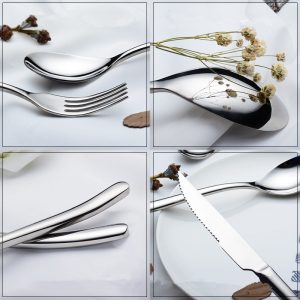The stainless steel cutlery with bright surfaces such as mirrors and no burrs have undergone multiple mirror polishing procedures. Polished knives and forks look more textured and more refined, and a gourmet meal is a treat. So the following is about the process of the mirror polishing process.
The functions of polishing processing technology mainly include: improving surface roughness, eliminating defects such as scratches, ash and fine cracks; reducing surface friction coefficient and improving wear resistance; improving physical and mechanical properties of parts and improving stress distribution on surface of parts; The precision of the parts ensures the assembly process; improves the gloss and brightness of the surface of the parts, meets the requirements of clean production; improves the service life of the parts and the whole machine; improves the bonding force between the plating layer and the substrate, and satisfies the decorative requirements of the appearance.
1.Mechanical mirror polishing
Polishing process
The purpose of polishing is to obtain a smooth and smooth surface. At this time, there is a very fine and uniform wear scar on the grinding surface. Polishing is divided into rough grinding and fine grinding.
(1) Rough grinding: Rough grinding is to modify the rough surface and irregular shape.
(2) Fine grinding: After rough grinding, the metal surface still has deep wear marks, which need to be eliminated in the fine grinding to prepare for polishing.
Surface polishing process
The polishing process is to obtain a glossy mirror-like surface finish. Most of the parts that are repeatedly polished with a polishing wheel have extremely slight unevenness on the surface of the part, which is commonly used for the modification of the surface of the plating.
Polishing is the final step of the surface of the coating or the surface of the part. The purpose is to eliminate the fine grinding marks remaining on the surface after the polishing process. The ideal polished surface should be a smooth, shiny, non-marking, non-embossed, pet-free, metal-free surface that is mirror-like. After grinding and polishing, the grinding surface changes.
2. Three-step mirror polishing
The three-step mirror polishing is a polishing power tool which is used in combination with three kinds of polishing materials such as composite louver disc, synthetic grinding disc and wool strip polishing disc for mirror polishing. The polishing process is a composite louver disc, synthetic grinding disc, and the surface polishing process is wool. Polished disc.
Step 1: composite louver
The composite louver disc structure combines a surface polishing material with a coated abrasive to remove rough surfaces and irregular shapes for rough grinding and preliminary fine grinding.
Step 2: Synthetic grinding disc
The highly concentrated abrasive is distributed over a sturdy non-woven base material to remove the glare or burrs on the stainless steel surface for fine grinding and preparation for polishing.
Step 3: wool polishing disc
The wool strip has good flexibility and is easy to accelerate the air flow cooling. It is suitable for polishing wax or pastes to achieve the final procedure of the bright mirror-like metal surface processing.

Our cutlery manufacturers generally uses mechanical mirror polishing. Each set of knives and knives undergoes several polishing processes to ensure that the surface of the knives is as bright as a mirror, and the food can be clearly displayed on the surface of the knives. The surface of the knife and fork is round and smooth, without burrs, and does not hurt the skin.

